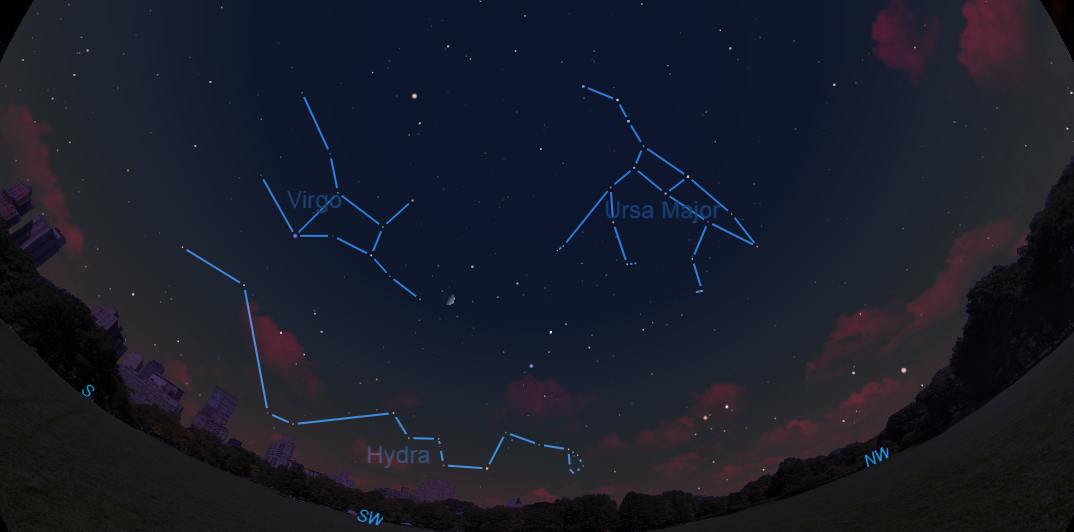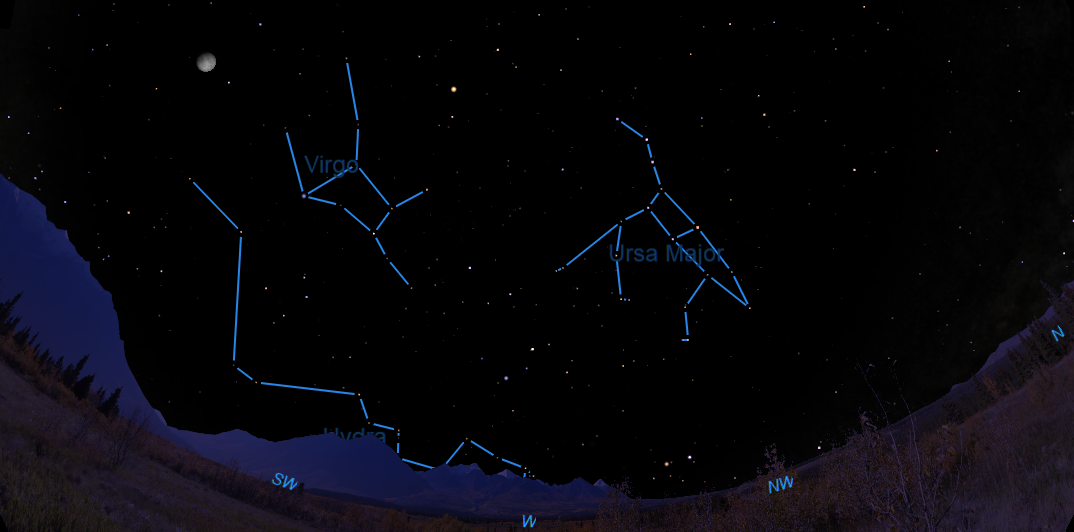The 3 biggest constellations will be on full display this June. Here's how to see them.
June presents a perfect opportunity to spot the three biggest constellations in the sky — Hydra, Virgo and Ursa Major — but you may have to look beyond standard star charts to find the Big Three.
Over the more than two decades that I've been writing about stars and constellations for Space.com, readers have occasionally asked me why the constellation patterns differ from similarly designed star charts and are not standardized. There are two main reasons: People see constellations in different ways, and modern astronomy does not consider constellations as star pictures but rather as specific sky areas.
All of the constellations shown in modern star atlases are officially approved by the International Astronomical Union (IAU), and the official boundaries for all 88 constellations were drawn up in 1930. Before that time, no two atlases agreed on the limits, and much confusion resulted.
Related: See 5 planets align in the night sky this month in a rare treat!
To see these boundaries, we need to consult a star atlas. Standard star charts that show the night sky for a particular time of the night and that include only the principal stars visible to the naked eye do not give an accurate idea of a constellation's size. For example, a map of the United States, or even a map of New York state, does not help you find your way around Manhattan; for that, you need a detailed street map. Similarly, star charts designed to show the positions of the constellations for a specific time of the night are only intended to give an overview.
Soon after darkness falls on these early June evenings, the "Big Three" — that is, the three largest constellations in our sky, Hydra (the Water Serpent), Virgo (the Maiden) and Ursa Major (the Great Bear) — will be in full view.
Overall, Hydra spans over 100 degrees of the sky and takes nearly seven hours to rise into full view. This tremendously long creature is not only the longest constellation but also the largest based on its area in square degrees, according to official boundaries established by the IAU. Hydra covers 1,304 square degrees, or about 3% of the entire sky, which isn't surprising considering the linear extent of this beast.
Breaking space news, the latest updates on rocket launches, skywatching events and more!
But it is far less obvious that Virgo is the second-largest constellation, with an area of 1,294 square degrees, followed by Ursa Major, at 1,280 square degrees.
Hence, the one-time picturesque patterns of people, animals and objects have evolved into arbitrarily defined areas of the sky. Let's take a closer look at these three big patterns that currently dominate our late-spring evening sky.
1. Hydra (the Water Serpent)
June's warmer evenings inspire many of us to spend more time under the sky, perhaps to seek out the smaller and less-conspicuous constellations. Observers in an area with a dark sky and a wide-open view toward the southern part of the sky will enjoy tracing out the great length of Hydra, sometimes called the Water Serpent or the Snake. The imagery dates back to 1200 B.C. and may be related to a more important beast: the dragon Tiamat of the Euphratean epic about the hero Gilgamesh.
Some also say, however, that Hydra commemorates the fabled multiheaded serpent that gave the mighty Hercules so much trouble. Yet our celestial Hydra has only one head, near the sickle of Leo. That head is a pretty little group of five stars worth looking for, about halfway between the bright stars Regulus and Procyon. From there, if the sky is clear and dark, you can follow the remaining scraggly stream of the snake's body; its zigzagging procession of faint stars leads south and east for more than an additional 90 degrees across the sky.
Related: What's the story behind the stars?
Hydra's brightest star is the second-magnitude Alphard, an orange giant about 177 light-years away and sometimes called "The Solitary One." Once you've found it, you'll understand why it's so named: It seems brighter than it is, because it's in a large, dull region and has no competition nearby.
Resting on the back of the Snake are two smaller constellations. Crater (the Cup) is a small, rather faint group. Farther south, though, where it rises higher, its graceful shape can be traced on a dark, clear night. Farther east is a little four-sided figure of fairly bright stars. This is Corvus (the Crow), which, like most constellations, bears little resemblance to the object it was supposed to represent; it's a small, moderately bright, quadrilateral-shaped pattern of stars. Add a fainter adjoining star, and the pattern resembles the battened mainsail of a Chinese junk.
Hydra, Crater and Corvus are connected by a myth: Corvus was the messenger of the god Apollo. Sent by the god to fetch a drink of water in the Cup, the Crow dallied under a fig tree until the figs were ripe to eat, then came home without the Cup but in the fangs of the Snake as an alibi. Thereupon the angry Apollo put Snake, Cup and Crow in the sky.
2. Virgo (the Maiden)
Occupying much of the southern sky these early evenings is the large, faint constellation Virgo (the Maiden). Unlike most of the ancient constellations, Virgo presents no distinctive pattern of stars to attract attention; most star maps show it resembling the letter Y written in cursive style. In Greek and Roman tradition, Virgo was identified with the goddess of justice, Astraea, who ruled the world during the fabled Golden Age. It has also been suggested that the Sphinx represents both Leo and Virgo, each of which hosts the sun during the Nile's crucial annual flooding.
In the old allegorical star books, the goddess holds some spikes of wheat in each hand, and her brightest star, bluish Spica, glows in one of the ears of grain hanging from her left hand. I predict that in 2026, Spica will get a lot of attention in the news media — not so much because it is among the brightest stars (it ranks 16th), but because the current and most definitive estimates of its distance place it at 250 light-years away. Thus, from July 4 through Aug. 2, 2026, those who look at Spica might very well be witnessing light that started on its journey toward Earth during the same time frame the Founding Fathers signed the Declaration of Independence.
Might, then, the media refer to Spica as "America's star"? (I should also point out that the true distance of Spica is known to within an accuracy of only +/- 10 light-years, so the starlight from 1776 may have already reached us or may not get here until 2036.)
Also located within Virgo is one of the most remarkable areas of the heavens, known as the Realm of the Galaxies. Here lies a celestial wonderland of star "cities," an amazing concentration of dimly luminous patches. Literally thousands of galaxies have been photographed here with great observatory instruments. Every one of these dim blobs is a star city, and the assertion by reputable astronomers is that the average mass of each galaxy is some 200 billion times the mass of the sun. The best estimates indicate that these star cities are located somewhere between 40 million and 70 million light-years from Earth.
3. Ursa Major (the Great Bear)
Late spring is when the Great Bear prowls the evening night sky almost directly overhead for most stargazers in the Northern Hemisphere. Scholars are fairly sure that the oldest star groups trace back to the people of Mesopotamia five or more millennia ago. In fact, the creatures that were made into the ancient Western constellations are similar to those in the Bible, and there are hints that some are far older. The fact that the Big Dipper formed a bear to Native Americans and to the cultures of the Old World and Siberia suggests that Ursa Major is a piece of Stone Age culture dating to at least 8,000 to 12,000 years ago, which is the estimated era of the last migration from Siberia to North America across the Bering Strait.
For much of the world, this pattern has been, if not a bear, some sort of wagon. Shakespeare's "Henry IV" refers to the Big Dipper as Charles' Wain. (A wain is a large, open farm wagon.) In Great Britain, it is better known as the Plough. But the Big Dipper visualized as a ladle is strictly an American phenomenon; this celestial "drinking gourd" was often mentioned in mid-19th-century books, but not before then.
As such, the Big Dipper itself has been a source of frustration to some constellation historians. Who invented this name? Nobody seems to know.
To envision the entire star pattern as a "Big Bear," the bear's nose is marked by the third-magnitude star Muscida. The bear's paws, known to early Arabs as the "Leaps of the Gazelle," are marked by an almost equally spaced set of three pairs of stars. The Dipper's bowl is the torso.
So what explains the abnormally long tail marked by the Dipper's handle? No bear that has ever walked Earth has possessed anything more than a stubby tail. But 19th-century British writer Thomas Hood once speculated as to the reason:
"Imagine that Jupiter, fearing to come too nigh unto her teeth, lay hold on her tail, and thereby drew her up into the heaven; so that she of herself being very weighty, and the distance from the earth to the heavens very great, there was great likelihood that her tail must stretch," Hood wrote. "Other reason know I none."
Joe Rao serves as an instructor and guest lecturer at New York's Hayden Planetarium. He writes about astronomy for Natural History magazine, the Farmers' Almanac and other publications. Follow us on Twitter @Spacedotcom and on Facebook.

Joe Rao is Space.com's skywatching columnist, as well as a veteran meteorologist and eclipse chaser who also serves as an instructor and guest lecturer at New York's Hayden Planetarium. He writes about astronomy for Natural History magazine, Sky & Telescope and other publications. Joe is an 8-time Emmy-nominated meteorologist who served the Putnam Valley region of New York for over 21 years. You can find him on Twitter and YouTube tracking lunar and solar eclipses, meteor showers and more. To find out Joe's latest project, visit him on Twitter.


